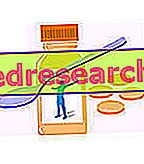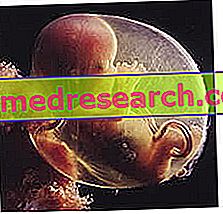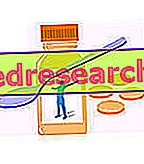Under the generic term "Klamath Algae" are sold food supplements containing green-blue microalgae, mainly belonging to the species Aphanizomenon flos-aquae ; the term Klamath is a clear reference to the origin of these algae, grown in the waters of the lake of the same name - Upper Klamath Lake - in Oregon (United States), then pulverized and dried before being put on the market.
In case of need, dietary supplementation with Klamath Algae can be useful to provide significant quantities of minerals, antioxidants and vitamins, useful to fill specific deficiencies or satisfy an increased need.

Use and nutritional properties
The recommended intake of Klamath algae for supplementary purposes is in the order of 2-3 grams per day, reaching five grams in exceptional cases. The product is available in powder or capsule form; generally, it is recommended to take it in a single dose in the morning by swallowing it with water.
| VITAMINS | QUANTITY per 3 grams of Klamath ® RW max | RDAs / RDA | |
| Vitamin A (from carotenes) | mg | 0.9 | 100% |
| Thiamine (B1) | mcg | 750 | 50% |
| Riboflavin (B2) | mcg | 115 | 7% |
Niacin (B3) | mg | 12 | 66% |
| B.C. pantothenic (B5) | mg | 4.65 | 75% |
| Pyridoxine (B6) | mcg | 85 | 4.5% |
| Folic acid (B9) | mcg | 120 | 60% |
| Cobalamin (B12) | mcg | 3 | 100% |
| C vitamin | mg | 6 | 10% |
| Vitamin E | mcg | 840 | 8.4% |
| Vitamin K | mcg | 150 | Over 100% |
Faced with such a limited contribution, not to be exceeded at least for prudence, it is natural to ask how such a dosage can be effective in significantly integrating the nutritional intake of micro and macronutrients. With reference to the latter (proteins, carbohydrates and lipids), it is clear that the nutritional contribution of this integrative strategy is modest and in any case lacks the miraculous tones with which it is promoted for commercial purposes. For example, if three grams of Klamath algae are consumed per day the content of essential amino acids, although being particularly high in relative terms (0.6-0.7 g of protein per gram of product), is too low in absolute terms, given that the Protein requirement of a 70 kg adult normal person is about 70 grams per day. At similar doses of intake, even the 15-18 mg of alpha linolenic acid (progenitor of the omega three) present in every gram of Alga Klamath are altogether modest: data in hand, against a daily requirement of α-linolenic acid in the order of 500-1000 mg, three grams of Alga Klamath cover only 5-10% of this requirement.
| MINERALS | QUANTITY per 3 grams of Klamath ® RW max | RDAs / RDA | |
| Football | mg | 45 | 5% |
| Phosphorus | mg | 48 | 6% |
| Iron | mg | 3-4 | 65-85% |
| Magnesium | mg | 9 | 3% |
| Zinc | mcg | 120 | 0.8% |
| Iodine | mcg | 54 | 36% |
| Copper | mcg | 24 | 2% |
| Fluorine | mg | 2.5 | 100% |
| Selenium | mcg | 3 | 5% |
| Manganese | mcg | 90 | 9% |
| Chrome | mcg | 3 | 6% |
| Molybdenum | mcg | 14 | 30% |
| Vanadium | mcg | 9 | 90% |
| Boron | mcg | 33 | 3.3% |
Therefore, if the consumer intends to resort to specific integrations of essential amino acids or omega three fatty acids, he should concentrate - respectively - on protein and amino acid supplements, and / or on the use of fish oils rich in EPA and DHA or vegetables rich in alpha linolenic acid (eg linseed oil, hemp oil, walnut oil, canola oil). In any case, it is up to the attending physician to indicate the supplementary protocol most appropriate to the individual case.
As far as micronutrients (vitamins and minerals) and the so-called phytochemicals are concerned, Klamath seaweed can be considered in all respects a valuable supplementary source, especially for the vegan population or for those who prefer the use of natural products to the synthesis counterpart .
As shown in the table, three grams of Klamath algae cover a large part of the daily requirement for certain vitamins and minerals. Also vitamin B12, whose bioavailability in plant sources has always been the subject of criticism, could be present in the Klamath algae in an at least partially bioavailable form [6], although other studies [11] deny this hypothesis. The presence of chlorophyll, polyphenols (caffeic acid) and phycocyanin, which together with the abundance of carotenoids, contribute to raising the antioxidant power of klamath seaweed is also reported. On this basis, al klamath algae is attributed a long series of benefits in the prevention and treatment of various conditions, in which the excess of free radicals or any nutritional deficits play an important role.
| Antioxidant carotenes (xanthophylls) | QUANTITY per 3 grams of Klamath ® RW max | ||
| canthaxanthin | mg | 1 | |
| Lutein | mg | 1.2 | |
| Zeaxanthin | mg | 0.3 | |
| Astaxanthin | mg | 0.1 | |
| Lycopene | mg | 0.1 | |
Evidence of Efficacy and Clinical Studies
In our opinion, the amount of studies published on pubmed is insufficient to justify miraculous attitudes towards this food supplement. By selecting only double-blind randomized placebo-controlled clinical trials, there is preliminary evidence of a possible utility in the treatment of depression and in improving psychophysical well-being in post-menopausal women not treated with TOS [7, 8], in addition to a possible stimulating effect on the immune system [9, 10]. Some of these studies refer to whole algae, others to specific patented extracts of klamath algae, such as Klamin ® (see bibliography) in which the alga is artificially enriched with particular substances, such as phycocyanins or phenylethylamine, in order to obtain the desired benefits. In this regard, a consideration appears to be a duty: if the klamath algae were indeed the prodigious miracle of nature punctually described for commercial purposes, why is it necessary to add substances in its extracts to obtain the achievement of specific health objectives? Applying the same reasoning, if one day an olive oil with anti-inflammatory included was marketed (increasing by 20 times the levels of oleocanthal naturally present in the food), someone could say that olive oil solves muscle pain and fever better ibuprofen! Too bad that in the absence of this enrichment in oleocanthal, to obtain the same result it would be necessary to take a dose of half a liter of olive oil!
The klamath alga remains however a "good natural tonic", characterized by a remarkable concentration of essential nutrients or in any case important for the health of the whole organism; however, the low recommended intake rates should objectively dampen excessive enthusiasm about the benefits obtainable from its use (increasing the intake doses beyond the recommended values is never advisable, let alone in this case, considering the potential risks described in the next chapter) .
Naturally, the properties of the klamath alga are also corroborated by the numerous studies on the single nutrients generously contained in it, which contribute to elevating the health utility in the context of a varied and balanced diet. For example, given the generous intake of folic acid and vitamin B12, klamath seaweed can be beneficial for individuals with high levels of homocysteine in the blood, which is why they are exposed to a greater cardiovascular risk. Also from this aspect are born the numerous health properties attributed to it for commercial purposes which, however, we repeat, for the most part have yet to be scientifically confirmed.
The Ministry of Health - as it is very prudent in recognizing the physiological and / or healthy properties of the various integrators - inserts the klamath alga in the list of substances permitted in food supplements (further proof of its safety in use), indicating - in reference to its physiological effects - as useful for the "Normal mood tone" 16. They are NOT recognized as being useful for "supporting and restorative action" (for example assigned to spirulina), or "antioxidants, natural defenses of the organism, depurative functions of the organism" (attributed to chlorella), although its values nutritional values are in many respects similar (and in some cases better) than the other algae cited. This aspect suggests how - for the klamath seaweed - scientific evidence to support its physiological and health effects is still scarce and therefore deserving of further investigation.
Safety of use and contraindications
Much has been said and written about the safety of use of klamath algae and the possible dangers to the health of the consumer. Before proceeding with the analysis of their nutritional characteristics and properties, it therefore appears necessary to take stock of this aspect, avoiding excessive alarmism.
Klamath algae (understood as A. flos-aquae microalgae extracted from Lake Klamath) are NOT in themselves toxic or dangerous for human health. However, they are subject to possible contamination by microcystins: a "global" problem that affects most of the aquifers on the planet [15]. Like aflatoxins in cereals and heavy metals in seaweeds (laminaria, fucus etc.), even fresh or brackish water algae (spirulina, chlorella, klamath ...) can be contaminated with toxic substances. In particular, similar to aflatoxins, microcystine contamination can cause serious liver problems; for this reason the aquifers and the various integrators are subjected to continuous checks. In some of these studies [1, 12, 13, 17], concentrations of microcystins higher than the safe limits suggested by the WHO for drinking water were detected in samples of A. flos-aquae . However - considering that: a) these limits are several hundred times lower than the dosages revealed toxic for the experimental animal, about which some authors have raised concerns about possible conflicts of interest (underlining the need to establish safety intervals wider, at least 5 times higher, which would turn off any controversy concerning safety of use by bringing all the samples analyzed into norm) [15], b) there were no cases of toxicity in humans deriving from the use of supplements of klamath alga, neither in Italy nor in other countries; c) the klamath seaweed contains good concentrations of potential natural antidotes (substantially antioxidants) against microcystins - it is good to avoid excessive alarmism: following the normally suggested intake doses (max 4 g / day) the consumer should not run significant dangers for the own health (although some authors have come to less reassuring conclusions, stating for example that: "At the highest levels of contamination found, a risk for consumers can be expected following chronic or sub-chronic exposure to a reasonable daily consumption of 4 g. "[12]). It is also necessary to point out that most of the samples analyzed have shown levels of contamination that are clearly inferior to the prudential limits of potential danger; it is therefore unfair that companies that operate professionally to guarantee superior quality and safety klamath algae extracts are penalized for non-observance of a few . Although some authors [13] come to consider "the commercial sale of products based on Aph. Flos-aquae for human consumption, in pure or mixed formulations, very questionable", it is however a supplement used for years in most part of the countries of the world without having recorded cases of microcystine toxicity.
Ultimately, for those wishing to supplement their diet with klamath-based algae products, we can recommend: a) a preventive medical consultation (as one should always do before taking any supplement); b) compliance with the intake doses suggested by the manufacturer; c) the choice of quality products and certificates d) to avoid the intake during pregnancy, lactation and under 12 years. Once these tips are respected, depriving yourself of this supplement due to the danger of microcystins does NOT seem to us to be a rational choice; for the same reason, most of the other supplements and even many foods should also be deprived. For those wishing to learn more about the safety of klamath algae, we recommend reading this article or the studies cited at the end of the article.
The fact that klamath algae can somehow stimulate the activity of the immune system [9, 10], requires particular caution in the course of autoimmune diseases (eg multiple sclerosis, lupus, rheumatoid arthritis and others) or concomitant use of immunosuppressive drugs, which could make its use contraindicated. The high content of vitamin K could interfere with drug therapies based on coumarin anticoagulants. Caution also in case of liver disease: consult a doctor.
BIBLIOGRAPHY
- Assessing potential health risks from microcystin toxins in blue-green algae dietary supplements "by Gilroy DJ, Kauffman KW, Hall RA, Huang X, Chu FS. Published in Environ Health Perspect. 2000 May; 108 (5): 435-9.
- Icroalga Klamath and cyanobacterial toxins. Stefano Scoglio. 2011
- USGS: Upper Klamath Lake nutrient study
- Effect of a Klamath algae product ("AFA-B12") on blood levels of vitamin B12 and homocysteine on vegan subjects: a pilot study. Baroni L, Scoglio S, Benedetti S, Bonetto C, Pagliarani S, Benedetti Y, Rocchi M, Canestrari F. Int J Vitam Nutr Res. 2009 Mar; 79 (2): 117-23.
- [Effects of Klamath Algae extract on psychological disorders and depression in menopausal women: a pilot study]. Genazzani AD, Chierchia E, Lanzoni C, Santagni S, Veltri F, Ricchieri F, Rattighieri E, Nappi RE. Minerva Ginecol. 2010 Oct; 62 (5): 381-8. Italian.
- Effect of a 2-month treatment with Klamin, a Klamath algae extract, on the general well-being, antioxidant profile and oxidative status of postmenopausal women. Scoglio S, Benedetti S, Canino C, Santagni S, Rattighieri E, Chierchia E, Canestrari F, Genazzani AD. Gynecol Endocrinol. 2009 Apr; 25 (4): 235-40.
- Natural killer cell activation and modulation of chemokine receptor profile in vitro by an extract from the cyanophyta Aphanizomenon flos-aquae. Hart AN, Zaske LA, Patterson KM, Drapeau C, Jensen GS.
- Mobilization of human CD34 + CD133 + and CD34 + CD133 (-) stem cells in vivo by consumption of an extract from Aphanizomenonflos-aquae - related to modulation of CXCR4 expression by an L-selectin ligand? Jensen GS, Hart AN, Zaske LA, Drapeau C, Gupta N, Schaeffer DJ, Cruickshank JA.
- Miyamoto E, Tanioka Y, Nakao T, Barla F, Inui H, Fujita T, Watanabe F, Nakano Y. Purification and characterization of a corrinoid-compound in an edible cyanobacterium Aphanizomenon flosaquae as a nutritional supplementary food. J Agric Food Chem. 2006 Dec 13; 54 (25): 9604-7.
- Vichi S, Lavorini P, Funari E, Scardala S, Testai E. Contamination by Microcystis and microcystins of blue-green algae food supplements (BGAS) on the Italian market and possible risk for the exposed population. Food Chem Toxicol. 2012 Dec; 50 (12): 4493-9. Higher Institute of Health, Environment and Primary Prevention Department, Rome, Italy.
- Heussner AH, Mazija L, Fastner J, Dietrich DR. Toxin content and cytotoxicity of algal dietary supplements. Toxicol Appl Pharmacol. 2012 Dec 1; 265 (2): 263-71.
- Gallo P. et al., Contamination by biotoxins in fish products and food supplements, in Food Ingredients, XI (2012) October, pp.6-11, p.10.
- Scoglio S., The business of microcystins
- Ministry of Health - List of substances and herbal preparations allowed in food supplements (updated July 2012)
- "AFA-Algen - Giftcocktail oder Gesundheitsbrunnen?" Universität Konstanz. 1, 2008. Retrieved May 18, 2012.



